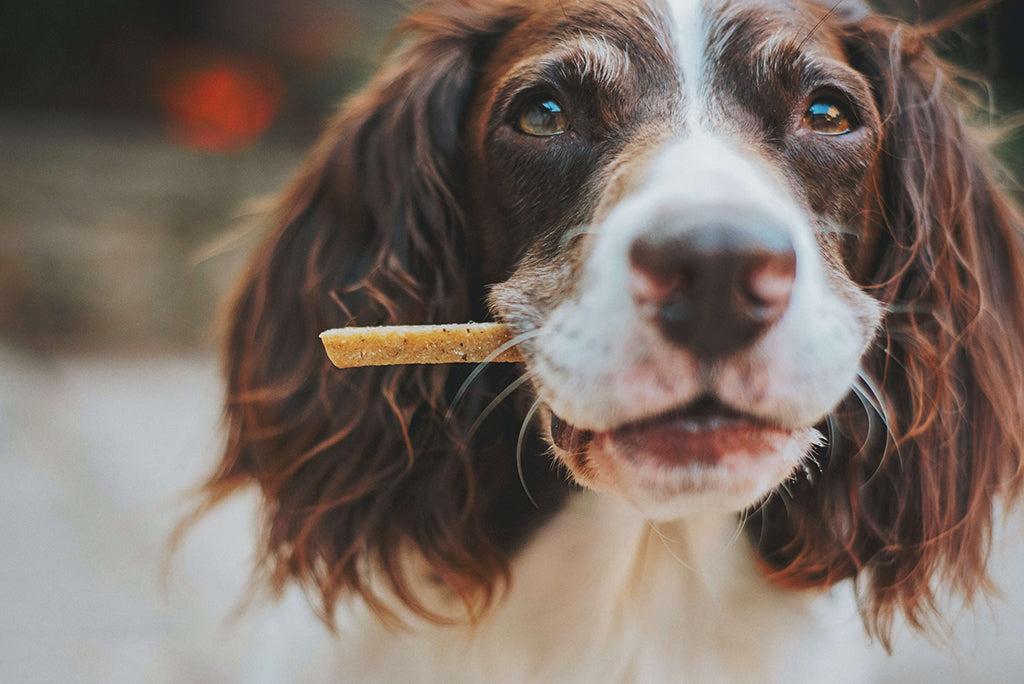You’ve worked out your dog’s daily food allowance, but what about their treat allowance? Do you count them? Well if not, it might be time to start doing your sums…
Treats, although essential for positive reinforcement, can mean your dog is getting more calories than they should, which can put them on the path to unwanted weight gain.
How Many Treats Is Too Many For A Dog?
Similarly to when we humans go for it at the all-inclusive buffet, too many treats for your pet can lead to too many calories and weight gain!
If your pooch isn’t burning off these excess calories by exercising enough, they’ll be stored as fat, leaving your pup at risk of possible complications.
Overweight or obese dogs are predisposed to having serious complications. Did you know that 56% of dogs in the USA are classed in the overweight or obese categories… That’s around 50 million dogs!
So, the amount you treat really does matter, and how many treats per day for a dog is an important query!

How Many Treats Per Day For A Dog?
It’s pretty complicated when it comes to a dog’s calorie allowance as every dog is different. Everything needs to be considered, such as:
- Your dog’s age – Puppies need more calories than older dogs because they burn more.
- Your dog’s activity level – The more your dog exercises, the more calories they will need.
- Your dog’s breed – Some breeds need daily, vigorous exercise, especially those that were originally bred for physically demanding jobs, like herding or hunting. So, knowing what amount of exercise your dog needs is essential, otherwise, they are at risk of putting on weight and may vent their unused energy through unwanted behaviors such as barking, chewing on furniture, and digging. So, how much daily exercise does your dog need…?

- Your dog’s weight – Adding or cutting calories is important if your dog is under or overweight.
- Your dog’s body condition – The amount of muscle to fat also affects the number of calories your pooch will need.
- Whether your dog is neutered – If your dog is spayed or neutered, this can slow their metabolic rate (how fast they burn calories) by around 5%.
Healthy Dog Treats
Treats can be a healthy and beneficial part of your dog’s diet, especially as part of their training routine. The occasional unhealthy treat is okay but remember: only in moderation.
So, how can you treat your dog healthily…?
Introduce healthy, and safe human food as treat alternatives
Many dogs can lack fiber in their diet, so popping the odd carrot or cooked pumpkin in your treat hand can deliver a suitable amount, along with supporting their bowel health, plus most pups like the taste!
You can also include apples (without the pips), blueberries, cucumbers, broccoli, and spinach as these are also fruit and veg types that can seriously benefit your pup’s diet, as well as work as replacement treats.
However, some human foods can be incredibly toxic for dogs. So, make sure the ones you decide to use as a treat are not included on the list below:

Look for low-calorie treats that are high in lean protein
Look for treats that are high in lean protein, meaning they’re lower in fat, and have a minimal amount of ingredients, meaning they shouldn’t contain any hidden nasties either! Alternatively, you could try cooking up small pieces of lean, grilled chicken, or as above, pieces of cucumber and segments of apple (minus the pips!) as treat alternatives. This will help with their fiber levels too!
Use kibble from your dog’s daily allowance of food, so you’re not adding any extra calories
If you feed your dog kibble, take a couple from their measured meal allowance out and use it throughout the day as a treat substitute! This is a particularly great tip for doggos already on a diet!

What about Dental Chews as treats?
Daily dental chews or sticks can be used as a big daily reward. Reputable pet brands usually design theirs specifically for your pet’s teeth and can help target plaque and oral debris as they chew. As well as tasting great, and making an excellent, healthy reward, good dental chews can help to scrape away potentially tartar and plaque build-up from the surface of the tooth itself – which in turn helps to maintain healthy teeth and gum tissue. Dental chews and sticks are also great at getting into the hard-to-reach places – with little effort on your part!
However, they should only be used alongside regular brushing but are an excellent addition to your dog’s daily dental routine.
Does My Dog Need Less Treats?
There’s a really easy way to assess whether your dog’s carrying a little excess baggage around with them! Simply place your palms on either side of your pup’s chest and lightly press down to check if you can feel their ribs. This area is where they accumulate fat. You should be able to feel their ribs upon light palpitation using your hands.
See where your pet ranks on the PetLab Co.’s Body Condition Assessor

PetLab Co. Pro Tip: If your dog is in the overweight category, simply reduce their food allowance by 10% until they reach their ideal body weight. They’ll barely notice the difference!
Final Thoughts
No matter what your furry friend’s preferences are when it comes to their treats, make sure their treat allowance is only 10% of their total food consumption per day to maintain a healthy weight. And, what size should each treat be? A treat should never be bigger than the nail on your first finger!
If you’re really worried about your dog’s weight though, always consult with a vet.
Related read: Rawhide Bones and Treats for Dogs







